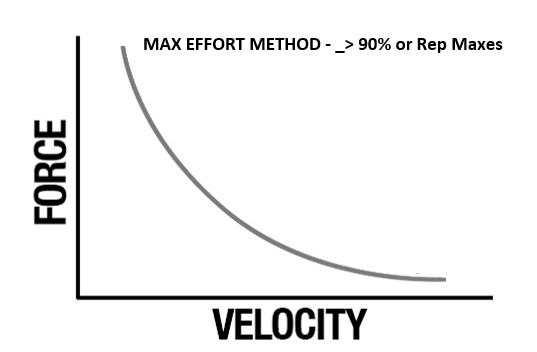
An excerpt from Conjugate U, coming soon to elitefts.com
“Maximal strength is the mother of all special strengths." — Dr. Mel C. Siff
I’m not going to list all of the special strengths here, but if you read Supertraining you will see many of the special strengths listed are direct precursors to our most desired sporting traits, such as change of direction, first step ability, speed, etc. On our force velocity curve, it may look like max effort work and top velocity are very distant, but in reality, they are very closely related.
If they aren’t, why do elite sprinters use steroids?
It sure as hell isn’t because being strong makes you slower. Athletes have been running and jumping their whole lives. You are only going to get so much improvement by doing more of this. For the most profound results we need to train the area of the force velocity curve (max effort) they have spent the least amount of time on.
When we first discussed why to use the conjugate method, we talked about shifting the force velocity curve to the right and upward. The final piece to the puzzle to do this is the max effort method — or in our system, heavy days. The most effective way to gain strength is to train at 90% and above. While this is very true, you need to know how to manipulate this method to avoid overtraining and get optimal results.
Athletes need to be strong. Most great athletes are really strong. They may not squat 800 pounds, but they are physically very strong. There are many examples of ex-football players coming into powerlifting and doing very well with very little experience. This happens because they are strong to start; they just had to learn the skill of lifting correctly to surpass people who had been lifting their entire lives.
If this is the case then why are so many people afraid to train their athletes to get strong?
Many times coaches say, “Sure he can squat X weight, but how would that help my athlete in Y sport?” Once again I’ll refer to middle school physics: force = mass x acceleration. Another reason we must get athletes strong is that a strong athlete is a durable athlete. You are not going to reach an athlete’s true strength potential without tapping into the 90% and above range on a regular basis. Another argument I hear against this method is, "Meh, I don’t need my athletes to be that strong.” Okay, so you don’t want your athletes to have every tool available at their disposal?
RECENT: Four-Week Block of Baseball Fall Training from Conjugate U for Position Guys and Pitchers
Being strong is never a detriment to athletic performance. You will never hear an athlete say, “I was just too strong today. It really held my performance back.” What sealed the deal for me was athlete feedback. Most of the athletes we worked with over the years loved this style of training, attributed many of their results to the training, and were not happy with the results they got from other methods when they were forced to use them.
How to Prep Novices to the System for Max Effort Work
When we have athletes who haven't trained in this system before, we DO NOT put them in max effort training from the start. Our progression usually looks like this:
- Week 1: Teach squat, bench, and pulls on respective days. Then get some sets in with a weight we feel they can move with acceptable speed and form. We may even spend 30-40 minutes on techniques of the main lift, teach a couple simple accessory movements, then get them out. We do whatever it takes to get a solid understanding of their main lift.
- Week 2: Speed sets on both max and speed days. The weight is slightly increased from Week 1. Form and bar speed are priorities.
- Week 3: Same as Week 2.
- Week 4: This is the week we typically introduce some sort of max effort work. It is usually the same protocol as the returners, but we are more cautious working them up and shut them down when form breaks. Remember, we can get strength gains by moving light weight as fast as possible. With the above model, you can start making strength gains in the first week while teaching proper form, because the majority of kids will pick the form up by the end of the first day.
If you are having trouble getting the majority (at least 80%) of your athletes ready for max effort work after this progression then seek help. This is the main focus of my clinics, learning how to coach effectively and how to fix technical aspects of the lifts. There are also many very good lifters around the country who are willing to help.












1. That questions from paragraph 7 has some validity. It may not take long for a athletically gifted hockey player from a 350lb squat to a 500lb squat, once the point of diminishing returns how much time and effort should be spent on the fairly negligible step from 500 to 520?
2. From the outside looking in, it looks a bit too much like training athlete like powerlifters (coming from a powerlifter) How many athletes truly need to be bench pressing in their programs when dumbbells work fine? How many athletes need to be doing slow, grind it out max effort deadlifts when clean/snatch pulls and/or Trap Bar deadlifts work fine? Why not just take the pieces that translate to being strong/athletic and leave behind so much of the powerlifting specificity?
I do not mean to be negative at all, I found this informative and creative, just giving my POV on the training system to optimize for traditional-sport athletes.
1. Good point and question. I honestly don't care how much they squat. The only reason I tested straight bar squats was because the kids and coaches wanted to know. I knew if t he kids trained with consistency and an acceptable amount of effort all would fall into place. Because I had that much faith in the system. Just get stronger! The system takes care of this. Like you mentioned though where is the point of diminishing returns. I think this is different for each athlete. Another reason I love this system is this: let's say we do have that 500 lb squatter like you talked about. We can make him stronger by NOT having nearly 500 lbs on him each week. We can get around this by using various bars and accommodating resistances. We can get him stronger with less weight. Then if we need to we, can re-prioritize strength but never neglect it because it's in the weekly rotation all year. Here's something to think about also...I had two track kids both under 200lbs. One parallel box squatted with a pause 585, the other did a sumo 3 pin pull with 635. I figured if anyone could de-prioritize strength it would be these two. So, we did that and they both had decreases in performance. As you can see I think this point of diminishing returns is highly personalized.
2. Conjugate is a STRENGTH program, not a powerlifting program. Remember, many of its theories and percentages are stolen from old Olympic weight lifting and track and field training. Conjugate was originally used in SOviet Russia where 40 plus Olympic sports trained. It was popularized by Westside which happens to be a powerlifting gym. Powerlifting is squat, bench and Deadlift. In the conjugate model with athletes, we did these actual exercises MAYBE a couple of times each YEAR. If you look at it this way, most of the other college programs are WAAAAAY more powerlifting based than Conjugate. I mentioned before I did not care what the athletes squat max was, same for bench press. The bench is just a great way to develop upper body strength and power. That's why we used it. If dumbells work just as well, use them.
"How many athletes need to be doing slow, grind it out max effort deadlifts when clean/snatch pulls and/or Trap Bar deadlifts work fine? Why not just take the pieces that translate to being strong/athletic and leave behind so much of the powerlifting specificity?"
Take the simplest movements and manipulate the load and bar speed and you can make them power developers. Using these simple movement allows you to get proper neuromuscular firing that everyone harps about lately. Clean and snatch variations often turn into a shit show. The athlete's arent' strong enough to execute them properly. How many athletes need to clean/ snatch pull when they can do speed pulls and jumps to obtain the same results. "Grinding' is a great way to reach untapped central nervous system potential. The movement done is irrelevant, that's why we change it each week. This is not to say you couldn't add the variations you talked about, I just don't think you have to. We kept it simple and have had great results. I think that's the error people make with the system, they try to make too many adjustments to it. I think people are going to be surprised at how simple our program was. I'm hoping this will help them adapt it because it's too powerful to not share and I want STRENGTH to be cool again!
Thanks for the questions and feedback!
Same question as Kevin above...book release date?
My goal is to have it written by the end of August. Then there's editing/ formatting...not sure on the turn around time on that. I want to have a pretty large exercise index with video, a lot of the writing is done.
Cheers,